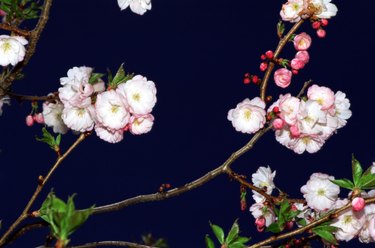
Flowering crabapples, also known as flowering crabs, are small, ornamental landscape trees that are prized for their attractive spring blossoms, which bloom in pleasing shades of pink, red or white. If the flowering crab tree in your garden or home landscape is losing its leaves prematurely, it may be infected with a harmful fungal disease such as apple scab or cedar apple rust.
Apple Scab
Video of the Day
Caused by the fungus Venturia inaequalis, apple scab is a botanical disease that infects apple and flowering crabapple trees, usually during moist weather. Small, irregular, brown or olive green lesions appear on the undersides of the leaves on newly infected trees. As the disease progresses, the lesions expand, deepen to an unsightly brown or black and cause the leaves to yellow, wrinkle and fall from the tree. The University of Kentucky Cooperative Extension Service cautions that severe apple scab infections may cause complete flowering crab tree defoliation by midsummer.
Video of the Day
Apple Scab Prevention and Control
According to the University of Illinois Extension, the simplest way to prevent apple scab infections is to select disease-resistant crabapple cultivars whenever possible. Follow a regular irrigation and fertilization regimen for your tree to keep its growth healthy and vigorous. Maintain lightly moist soil, but avoid allowing it to become soggy or waterlogged; overly wet soils can invite or exacerbate fungal diseases. Most apple scab infections occur between late April and early June; spray your flowering crab tree regularly with a preventative fungicide during this period. Always use fungicide products according to package directions. If your tree does get infected, remove diseased foliage, flowers and fruit with sharpened and sterilized pruning shears. Once a tree is infected, it is too late to use a fungicide spray to control the disease; use preventative measures the following season.
Cedar Apple Rust
Cedar apple rust is a fungal disease caused by the fungus Gymnosporangium juniperi-virginianae. Cedar apple rust spores start their life cycle on a juniper tree or shrub and then spread to nearby apple or flowering crab trees. The first signs of the disease are bright, orange-yellow spots that appear on the tree's leaves, usually in late spring or early summer. The disease can also affect the crabapples themselves; leaves and fruits with numerous lesions often drop from the tree in the summer.
Cedar Apple Rust Prevention and Control
Minimize the risk of cedar apple rust infection by selecting a disease-resistant flowering crab tree from your local garden center or nursery. The University of Missouri Extension cautions against planting both junipers and flowering crabapple trees in your home landscape to prevent cedar apple rust infections. Spray your flowering crab with a preventative fungicide, spring through summer. Consult the instructions included with the product for recommended treatment frequency and application information.
- Colorado State University Extension; Flowering Crabapple Trees; J. Klett, et al.; February 2008
- Clemson University Cooperative Extension; Crabapple; Debbie Shaughnessy, et al.; May 1999
- University of Kentucky Cooperative Extension Service; The Flowering Crabapple; R.E. Durham, et al.
- University of Illinois Extension; Apple Scab; James Schuster, et al.
- University of Missouri Extension; Cedar Apple Rust on Crabapples; Dennis Patton
- North Dakota State University Extension Service; Questions on Flowering Crab; Ron Smith
- North Dakota State University Extension Service: Flowering Crabapple